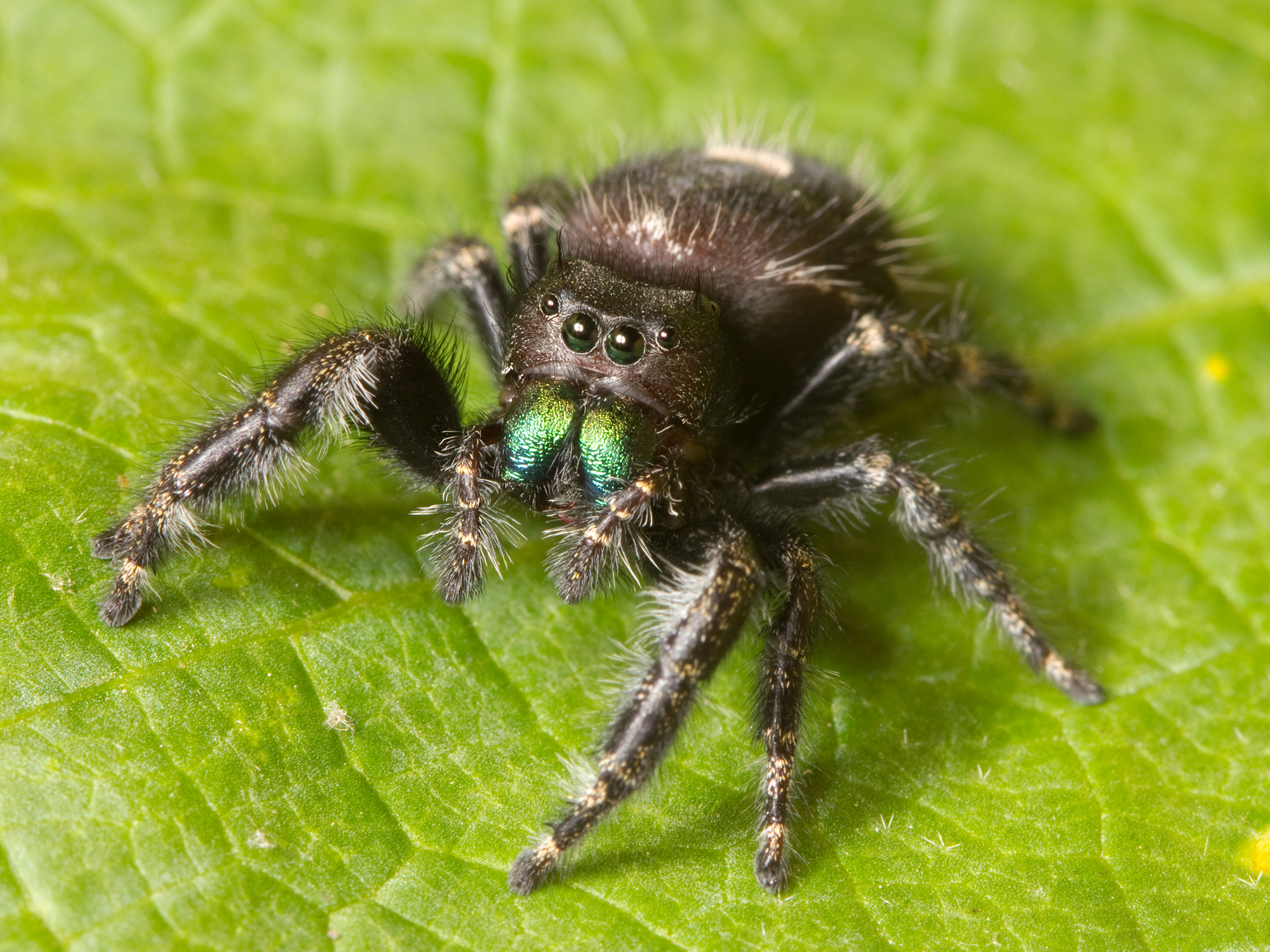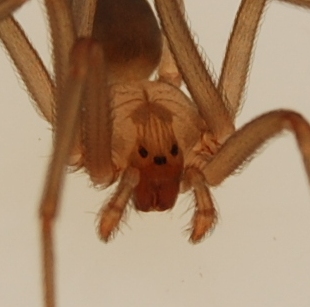|
Spider Bite
A spider bite, also known as arachnidism, is an injury resulting from the bite of a spider. The effects of most bites are not serious. Most bites result in mild symptoms around the area of the bite. Rarely they may produce a necrotic skin wound or severe pain. Most spiders do not cause bites that are of importance. For a bite to be significant, substantial envenomation is required. Bites from the Latrodectus, widow spiders involve a neurotoxic venom which produces a condition known as latrodectism. Symptoms may include pain which may be at the bite or involve the chest and abdomen, sweating, muscle cramps and vomiting among others. Bites from the recluse spiders cause the condition loxoscelism, in which local necrosis of the surrounding skin and widespread hemolysis, breakdown of red blood cells may occur. Headaches, vomiting and a mild fever may also occur. Other spiders that can cause significant bites include the Australian funnel-web spider and Phoneutria fera, South Ameri ... [...More Info...] [...Related Items...] OR: [Wikipedia] [Google] [Baidu] [Amazon] |
Chelicerae
The chelicerae () are the arthropod mouthparts, mouthparts of the subphylum Chelicerata, an arthropod group that includes arachnids, horseshoe crabs, and sea spiders. Commonly referred to as "jaws", chelicerae may be shaped as either articulated fangs, or as a type of pincer_(biology), pincers. Some chelicerae, such as those found on nearly all spiders, are hollow and contain (or are connected to) venom glands, used to inject venom into prey or a perceived threat. Both pseudoscorpions and Opiliones , harvestmen have additional structures on their chelicerae that are used for grooming (papillae in pseudoscorpions, cheliceral teeth in Opiliones). In ''Paratrechalea'', males and females have shown to have a chelicerae dimorphism, because the chelicerae is used as a mating signal for females. Types Chelicerae can be divided into three kinds: jackknife chelicerae, scissor chelicerae, and three-segmented wikt:chelate, chelate chelicerae. Jackknife chelicerae The jackknife chelicer ... [...More Info...] [...Related Items...] OR: [Wikipedia] [Google] [Baidu] [Amazon] |
Pesticide
Pesticides are substances that are used to control pests. They include herbicides, insecticides, nematicides, fungicides, and many others (see table). The most common of these are herbicides, which account for approximately 50% of all pesticide use globally. Most pesticides are used as plant protection products (also known as crop protection products), which in general protect plants from weeds, fungi, or insects. In general, a pesticide is a chemical or biological agent (such as a virus, bacterium, or fungus) that deters, incapacitates, kills, or otherwise discourages pests. Target pests can include insects, plant pathogens, weeds, molluscs, birds, mammals, fish, nematodes (roundworms), and microbes that destroy property, cause nuisance, spread disease, or are disease vectors. Along with these benefits, pesticides also have drawbacks, such as potential toxicity to humans and other species. Definition The word pesticide derives from the Latin ''pestis'' (plagu ... [...More Info...] [...Related Items...] OR: [Wikipedia] [Google] [Baidu] [Amazon] |
White-tailed Spider
White-tailed spiders are spiders native to southern and eastern Australia, with the name referring to the whitish tips at the end of their abdomens. The body size is up to 18 mm, with a leg-span of 28 mm. Common species are ''Lampona cylindrata'' and ''Lampona murina''. Both these species have been introduced species, introduced into New Zealand. White-tailed spiders are vagrant hunters that seek out and envenom prey rather than spinning a web to capture it; their preferred prey is other spiders. They are reported to bite humans, with effects including a red mark, and local itchiness, swelling and pain. On rare occasions, bites can cause nausea, vomiting, malaise or headache. Although ulcer (dermatology), ulcers and necrosis have been attributed to the bites, a scientific study by Isbister and Michael R. Gray, Gray (2003) showed they had other causes, mostly infections. A study of 130 white-tailed spider bites found no necrotic ulcers or confirmed infections. Taxono ... [...More Info...] [...Related Items...] OR: [Wikipedia] [Google] [Baidu] [Amazon] |
Loxosceles
The recluse spiders (''Loxosceles'' (), also known as brown spiders, fiddle-backs, violin spiders, and reapers, are a genus of spiders that were first described by R. T. Lowe in 1832. They are venomous spiders known for their bite, which sometimes produces a characteristic set of symptoms known as loxoscelism. Recluse spiders are now identified as members of the family Sicariidae, having formerly been placed in their own family, the Loxoscelidae. Although recluse spiders are feared, they are usually not aggressive. Relation with other spiders Sicariidae are of the superfamily Scytodoidea. Other families in the Scytodoidea include Drymusidae, Scytodidae, and Periegopidae. Habitat and appearance ''Loxosceles'' is distributed nearly worldwide in warmer areas. All have six eyes arranged in three groups of two (dyads) and some are brownish with a darker brown characteristic violin marking on the cephalothorax. However, the "violin marking" cannot be used as a reliable way to ... [...More Info...] [...Related Items...] OR: [Wikipedia] [Google] [Baidu] [Amazon] |
Cutaneous Condition
A skin condition, also known as cutaneous condition, is any medical condition that affects the integumentary system—the organ system that encloses the body and includes skin, nails, and related muscle and glands. The major function of this system is as a barrier against the external environment. Conditions of the human integumentary system constitute a broad spectrum of diseases, also known as dermatoses, as well as many nonpathologic states (like, in certain circumstances, melanonychia and racquet nails). While only a small number of skin diseases account for most visits to the physician, thousands of skin conditions have been described. Classification of these conditions often presents many nosological challenges, since underlying causes and pathogenetics are often not known. Therefore, most current textbooks present a classification based on location (for example, conditions of the mucous membrane), morphology ( chronic blistering conditions), cause ( skin conditions res ... [...More Info...] [...Related Items...] OR: [Wikipedia] [Google] [Baidu] [Amazon] |
Redback Spider
The redback spider (''Latrodectus hasselti''), also known as the Australian black widow, is a species of highly venomous spider believed to originate in Australia, but which is now found in Southeast Asia and New Zealand. It has also been found in packing crates in the United States with colonies elsewhere outside Australia. It is a member of the Cosmopolitan distribution, cosmopolitan genus ''Latrodectus'', the widow spiders. The adult female is easily recognised by her spherical black body with a prominent red stripe on the upper side of her abdomen and an hourglass-shaped red/orange streak on the underside. Females usually have a body length of about , while the male is much smaller, being only long. Mainly nocturnal, the female redback lives in an untidy web in a warm sheltered location, commonly near or inside human residences. It preys on insects, spiders and small vertebrates that become ensnared in its web. It kills its prey by injecting a complex venom through its t ... [...More Info...] [...Related Items...] OR: [Wikipedia] [Google] [Baidu] [Amazon] |
Tarantism
'' Lycosa tarantula'' carrying her offspring Tarantism ( ) is a form of hysteric behaviour originating in Southern Italy, popularly believed to result from the bite of the wolf spider '' Lycosa tarantula'' (distinct from the broad class of spiders also called tarantulas). A better candidate cause is '' Latrodectus tredecimguttatus'', commonly known as the Mediterranean black widow or steppe spider, although no link between such bites and the behaviour of tarantism has ever been demonstrated. However, the term historically is used to refer to a dancing mania – characteristic of Southern Italy – which likely had little to do with spider bites. The tarantella dance supposedly evolved from a therapy for tarantism. History It was originally described in the 11th century. The condition was common in Southern Italy, especially in the province of Taranto, during the 16th and 17th centuries. There were strong suggestions that there is no organic cause for the heightened excitab ... [...More Info...] [...Related Items...] OR: [Wikipedia] [Google] [Baidu] [Amazon] |
Anaphylaxis
Anaphylaxis (Greek: 'up' + 'guarding') is a serious, potentially fatal allergic reaction and medical emergency that is rapid in onset and requires immediate medical attention regardless of the use of emergency medication on site. It typically causes more than one of the following: an itchy rash, throat closing due to swelling that can obstruct or stop breathing; severe tongue swelling that can also interfere with or stop breathing; shortness of breath, vomiting, lightheadedness, loss of consciousness, low blood pressure, and medical shock. These symptoms typically start in minutes to hours and then increase very rapidly to life-threatening levels. Urgent medical treatment is required to prevent serious harm and death, even if the patient has used an epinephrine autoinjector or has taken other medications in response, and even if symptoms appear to be improving. Cause, mechanism, and diagnosis Common causes include allergies to insect bites and stings, allergies to fo ... [...More Info...] [...Related Items...] OR: [Wikipedia] [Google] [Baidu] [Amazon] |
Antivenom
Antivenom, also known as antivenin, venom antiserum, and antivenom immunoglobulin, is a specific treatment for envenomation. It is composed of antibodies and used to treat certain venomous bites and stings. Antivenoms are recommended only if there is significant toxicity or a high risk of toxicity. The specific antivenom needed depends on the species involved. It is given by injection. Side effects may be severe. They include serum sickness, shortness of breath, and allergic reactions including anaphylaxis. Antivenom is traditionally made by collecting venom from the relevant animal and injecting small amounts of it into a domestic animal. The antibodies that form are then collected from the domestic animal's blood and purified. Versions are available for spider bites, snake bites, fish stings, and scorpion stings. Due to the high cost of producing antibody-based antivenoms and their short shelf lives when not refrigerated, alternative methods of production of antiven ... [...More Info...] [...Related Items...] OR: [Wikipedia] [Google] [Baidu] [Amazon] |
Opioids
Opioids are a class of Drug, drugs that derive from, or mimic, natural substances found in the Papaver somniferum, opium poppy plant. Opioids work on opioid receptors in the brain and other organs to produce a variety of morphine-like effects, including analgesic, pain relief. The terms "opioid" and "opiate" are sometimes used interchangeably, but the term "opioid" is used to designate all substances, both natural and synthetic, that bind to opioid receptors in the brain. Opiates are alkaloid compounds naturally found in the opium poppy plant ''Papaver somniferum''. Medically they are primarily used for pain relief, including anesthesia. Other medical uses include suppression of diarrhea, replacement therapy for opioid use disorder, and Cold medicine, suppressing cough. The opioid receptor antagonist naloxone is used to reverse opioid overdose. Extremely potent opioids such as carfentanil are approved only for Veterinary medicine, veterinary use. Opioids are also frequently use ... [...More Info...] [...Related Items...] OR: [Wikipedia] [Google] [Baidu] [Amazon] |




